Fleet Air Arm
| Fleet Air Arm | |
|---|---|
| Founded | 1937 |
| Country | United Kingdom |
| Size | 6,200 personnel 240 aircraft[1] 206 combat capable |
| Part of | Royal Navy |
| Engagements | World War II Korean War Operation Musketeer (Suez Crisis) Falklands War Gulf War Afghanistan War Iraq War |
| Commanders | |
| Commodore-in-Chief | HRH Prince Andrew, Duke of York |
| Insignia | |
| Roundels |   |
| Aircraft flown | |
| Attack | Harrier, Lynx |
| Patrol | Merlin, Lynx |
| Trainer | Firefly, Tutor, Hawk, Jetstream |
| Transport | Sea King |
 Naval Service
of the British Armed Forces
|
|---|
| Components |
|
Surface fleet Fleet Air Arm Submarine Service Royal Naval Reserve Nursing Service (QARNNS) Royal Fleet Auxiliary |
| Royal Marines Reserve |
| History and future |
| History of the Royal Navy History of the Royal Marines Customs and traditions Future of the Royal Navy |
| Ships |
| Current fleet Current deployments Historic ships |
| Personnel |
| The Admiralty Senior officers Uniforms Officer rank insignia Ratings rank insignia |
| Related civilian agencies of the Ministry of Defence |
Royal Maritime Auxiliary Service |
The Fleet Air Arm (FAA) is the branch of the British Royal Navy responsible for the operation of aircraft. The Fleet Air Arm operates the AgustaWestland Merlin, Westland Sea King and Westland Lynx helicopters, as well as the Harrier GR7/GR9. Helicopters such as the Lynx and Westland Wasp have been deployed on smaller vessels since 1964, taking over the roles once performed by biplanes such as the Fairey Swordfish.
Contents |
History
Beginnings
British naval flying started in 1909, with the construction of an airship for naval duties.[2] In 1911 the Royal Navy graduated its first aeroplane pilots at the Royal Aero Club flying ground at Eastchurch, Isle of Sheppey under the tutelage of pioneer aviator George Bertram Cockburn, [3] but in May 1912 naval and army aviation were combined to become the Royal Flying Corps (RFC). The Naval Wing of the RFC lasted until July 1914 when the Royal Navy reformed its air branch, under the Air Department of the Admiralty, naming it the Royal Naval Air Service (RNAS).[4]
By the outbreak of the First World War, in August 1914, the RNAS had more aircraft under its control than the remaining RFC. The main roles of the RNAS were fleet reconnaissance, patrolling coasts for enemy ships and submarines, attacking enemy coastal territory and defending Britain from enemy air-raids, along with deployment along the Western Front. In April 1918 the RNAS, which at this time had 67,000 officers and men, 2,949 aircraft, 103 airships and 126 coastal stations, merged with the RFC to form the Royal Air Force.
Fleet Air Arm
On 1 April 1924, the Fleet Air Arm of the Royal Air Force was formed, encompassing those RAF units that normally embarked on aircraft carriers and fighting ships.[5] On 24 May 1939 the Fleet Air Arm was returned to Admiralty control[6] under the Inskip Award and renamed the Air Branch of the Royal Navy. At the onset of the Second World War, the Fleet Air Arm consisted of 20 squadrons with only 232 aircraft. By the end of the war the worldwide strength of the Fleet Air Arm was 59 aircraft carriers, 3,700 aircraft, 72,000 officers and men, and 56 air stations. The aircraft carrier had replaced the battleship as the Fleet's capital ship and its aircraft were now strike weapons in their own right.
Post-war history
After the war the FAA needed to fly jet aircraft from their carriers. The jet aircraft of the era were considerably less effective at low speeds than propeller aircraft, but propeller aircraft could not effectively fight jets at the high speeds flown by jet aircraft. The FAA took on its first jet, the Sea Vampire, in the late 1940s. The Sea Vampire was the first jet credited with taking off and landing on a carrier. The Air Arm continued with high-powered prop aircraft alongside the new jets resulting in the FAA being woefully outpowered during the Korean War. Nevertheless, jets were not yet wholly superior to propeller aircraft and a flight of ground-attack Hawker Sea Furies downed a MiG-15 and damaged others in an engagement.
As jets became larger, more powerful and faster they required more space to take off and land. The US Navy simply built much larger carriers. The Royal Navy had a few large carriers built and completed after the end of the war but another solution was sought. This was partly overcome by the introduction of a Royal Navy idea to angle the flight deck away from the centre line so that the aircraft landing had a clear run away from the usual forward deck park. An associated British invention, intended to provide more precise optical guidance to aircraft on final approaching the deck, was the Fresnel lens optical landing aid. Another Royal Navy invention was the use of a steam powered catapult to cater for the larger and heavier aircraft (both systems were adopted by the US Navy).
The phasing out of the larger, heavier aircraft led to the introduction of the Hawker Siddeley Harrier VTOL aircraft, which could be operated from any size of ship. Defence cuts across the British armed forces during the 1960s led to the cancellation of all Royal Navy aircraft carriers, but a new series of cruiser-sized carriers, the Invincible class, were built and equipped with the Sea Harrier. These carriers incorporated an upswept forward section of the flight deck that deflected the aircraft upward on launch and permitted heavier loads to be carried by the Harrier, for example in weaponry, and the system was used extensively in the Falklands war. The Harrier went on to form the basis of the Royal Navy's fixed-wing strike forces. Two new Royal Navy carriers are under development (2009) to launch the F-35 STOVL aircraft under development in the United States by Lockheed Martin, for which the Royal Navy has indicated its intentions to purchase significant numbers.
Helicopters also became important combat vehicles starting in the 1960s. At first they were employed on the carriers alongside the fixed-wing aircraft, but later they were also deployed on most smaller ships. Today at least one helicopter is found on all ships of frigate size or larger. Wasps and Sea Harriers played an active part in the 1982 Falkland Islands conflict, while Lynx helicopters played an attack role against Iraqi patrol boats in the 1991 Gulf War and Commando Sea Kings as well as the Lynx HMA Mk 8 from HMS Argyll, assisted in suppressing rebel forces in Sierra Leone.
The Fleet Air Arm has a museum near RNAS Yeovilton (HMS Heron) in Somerset, England at which many of the great historical aircraft flown by the Service are on display, along with aircraft from other sources. There is also a Fleet Air Arm museum inside the Museum of Transport and Technology (MOTAT) in Auckland, New Zealand. On display there is a full-size replica Fairey Swordfish, along with historic items and memorabilia.
The FAA today
The Fleet Air Arm has approximately 6,200 personnel, which is over 15% of the Royal Navy's total strength. They operate about 200 combat aircraft and over 50 support and training aircraft.[1] The Harrier GR9 strike aircraft, along with the Harrier T12 two-seat trainer variant are shared with the Royal Air Force as part of the Joint Force Harrier. Naval pilots train to fly the Harrier at the Joint Force Harrier Operational Conversion Unit (20(R) Squadron) at RAF Wittering in Cambridgeshire.[7]
Squadrons
Fleet Air Arm squadrons are named "# NAS", where # is a number; and NAS means Naval Air Squadron. The nomenclature used by the FAA is to assign numbers in the 700-799 range to training and operational conversion squadrons and numbers in the 800-899 range to operational squadrons. During WWII the 1700 and 1800 ranges were also used for operational squadrons.
Squadrons active in the FAA are:[8]
| Squadron | Aircraft | Base |
|---|---|---|
| 700W Naval Air Squadron | Lynx Wildcat | Yeovilton |
| 702 Naval Air Squadron | Lynx | Yeovilton |
| 703 Naval Air Squadron | (G115 Tutor from Nov 09) | Barkston Heath |
| 705 SquadronNote 1 | Squirrel HT.1 and HT.2 | Shawbury |
| 727 Naval Air Squadron | Grob G 115 Tutor | Yeovilton |
| 750 Naval Air Squadron | Jetstream | Culdrose |
| 771 Naval Air Squadron | Sea King HAR.5 | Culdrose |
| 792 Naval Air Squadron | Mirach drones | Culdrose |
| 800 Naval Air Squadron | Harrier GR.9/9A | Cottesmore |
| 814 Naval Air Squadron | Merlin HM.1 | Culdrose |
| 815 Naval Air Squadron | Lynx HAS.3/HMA.8 | Yeovilton |
| 820 Naval Air Squadron | Merlin HM.1 | Culdrose |
| 824 Naval Air Squadron | Merlin HM.1 (OCU) | Culdrose |
| 845 Naval Air Squadron | Sea King HC.4/HC.4+ | Yeovilton |
| 829 Naval Air Squadron | Merlin HM.1 | Culdrose |
| 846 Naval Air Squadron | Sea King HC.4/HC.4+ | Yeovilton |
| 847 Naval Air Squadron | Lynx AH.7/9 | Yeovilton |
| 848 Naval Air Squadron | Sea King HC.4/HAS.6(CR) | Yeovilton |
| 849 Naval Air Squadron | Sea King ASaC.7 | Culdrose |
| 854 Naval Air Squadron | Sea King ASaC.7 | Culdrose |
| 857 Naval Air Squadron | Sea King ASaC.7 | Culdrose |
| HMS Gannet SAR Flight | Sea King HAR.5 | Prestwick |
Note:
1. Designated 705 Squadron rather than a NAS due to being an integral part of the Defence Helicopter Flying School.
Culdrose (HMS Seahawk) is near Helston in Cornwall and Yeovilton (HMS Heron) is near Ilchester in Somerset. Their satellites or relief airfields are at Predannack and Merryfield respectively.
Squadrons that were active at some point can be found in the List of Fleet Air Arm aircraft squadrons.
In 1938, Admiralty Fleet Orders 2885 announced the formation of an Air Branch of the Royal Naval Reserve. Thirty three unmarried men signed up for 18 months full-time flying training; however, before these first volunteers were able to gain their wings Britain was at war.
At the end of hostilities in 1945 the RNVR(A) was 46,000 strong, with over 8000 aircrew. Post war the RNVR(A) comprised 12 dedicated reserve squadrons, grouped regionally into Air Divisions. However, defence cuts in 1957 disbanded the five Air Divisions, and the following year the RNVR was merged with the RNR.
The RNR Air Branch was commissioned at RNAS Yeovilton on 16 July 1980, and shortly afterwards 38 ex-regular aircrew began refresher training. Today the Air Branch comprises approx 250 ex-regular service Officers and Ratings, covering all aviation trades, tasked to support the Fleet Air Arm.
Operational aircraft
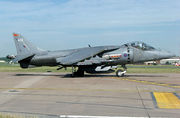
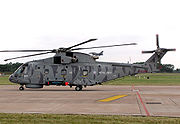
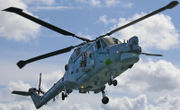
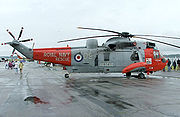
The FAA operates fixed-wing and rotary-wing aircraft. The FAA uses the same designation system for aircraft as the RAF.
Five types of fixed-wing aircraft are operated by the FAA; four for training, and one operationally.
Pilot training is carried out using the Grob Tutor and Slingsby Firefly.
Observer training is done in the Jetstream T2.
The most famous of the fixed-wing aircraft of the FAA was the Sea Harrier FA2. Its primary role was as a fleet defence fighter, using AMRAAM missiles, but it also carried out strike and Suppression of Enemy Air Defence missions using bombs. It has been replaced in FAA service by the Harrier GR7/GR9, which is a dedicated ground attack variant.
The fifth type is the Hawk T1, which is used to simulate enemy aircraft for training purposes, from AEW to Fighter Control, to air-to-air combat for Harrier pilots.
Today the larger section of the FAA is the rotary-wing part. Its aviators fly four types of helicopter, and within each type there are usually several marks/versions which carry out different roles.
Pilots designated for rotary wing service train at the Defence Helicopter Flying School, RAF Shawbury. The School is a tri-Service organisation consisting of civilian and military instructors (including Naval instructors and a Naval Squadron) that take the student from basic flying through to more advanced flying such as instrument flying, navigation, formation and captaincy.
The oldest aircraft in the fleet is the Westland Sea King, which performs missions in several versions. The Sea King HC4 serves as a medium-lifter and troop-transporter in support of the Royal Marines. The HAS5U model operates in the search and rescue and utility roles, while the Sea King HU5 is designed for search and rescue work (although the HAS5Us are often called HU5s as well). The HAS6C is used for assault transport training; and the ASaC7 operates in the AEW role on board Britain's aircraft carriers.
Intermediate in age is the Westland Lynx. The Lynx AH7s serve the FAA in the observation and anti-armour helicopter roles, but are mainly a light-lift helicopter. Along with the Sea King HC4s, they are part of the Commando Helicopter Force, which provides support to 3 Commando Brigade of the Royal Marines.
The surface combatants of the Royal Navy have their helicopters provided for the most part by the Lynx HAS3 and HMA8 aircraft. These Lynxes have primarily an anti-submarine warfare role and anti-surface vessel role. They are able to fire the Sea Skua anti-surface missile, which was used to combat the Iraqi navy in the 1991 Gulf War. It can be armed with Stingray air-launched torpedoes and depth charges for anti-submarine warfare, as well as a machine gun. The Lynx was originally envisaged for surface combatants that were too small for the Sea King, but now equips most surface ships of the Royal Navy.
The newest helicopter in the FAA is the AgustaWestland Merlin HM1. This has now replaced the Sea King HAS6 in the Anti-Submarine Warfare (ASW) role, and is deployed on aircraft carriers in addition to some of the other surface ships of the Royal Navy. The EH101 airframe is also one of the contenders to replace the Sea King ASaC7s in the AEW role on Britain's planned new aircraft carriers.
In 2000 the Sea Harrier force was merged with the RAF's Harrier GR7 fleet to form Joint Force Harrier. The Fleet Air Arm began withdrawing the Sea Harrier from service in 2004 with the disbandment of 800 NAS. 801 NAS disbanded on 28 March 2006 at RNAS Yeovilton (HMS Heron). 800 and 801 NAS were then combined to form the Naval Strike Wing, flying ex-RAF Harrier GR7 and GR9s. On 1 April 2010, NSW reverted to the identity of 800 Naval Air Squadron.[9]
Plans
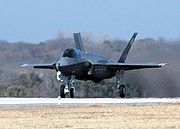
The Royal Navy plans to replace the Harrier force with the STOVL F-35B Lightning II from 2014. These new aircraft will operate from the Navy's new Queen Elizabeth class aircraft carriers, which are expected to be almost four times larger than the current carriers and operate between 40-50 aircraft and helicopters.
Notable members
- Vice-Admiral Richard Bell Davies VC CB DSO AFC (1886–1966) - the first naval aviator to receive the VC and the first naval aviator of the Fleet Air Arm to reach flag rank (Rear-Admiral Naval Air Stations, at HMS Daedalus, 1939–41)
- Vice-Admiral Sir Lumley Lyster KCB CVO CBE DSO (1888–1957) - drew up attack plan in 1935 that was used for the Battle of Taranto five years later, for which he flew his flag as Flag Officer Mediterranean Aircraft Carriers in HMS Illustrious. A distinguished seaman and naval aviator, all four of his appointments as a flag officer, between 1940 and 1945, were in naval aviation (two of them at sea).
- Admiral Sir Reginald Portal (1894–1983) - naval aviator who was the younger brother of Marshal of the Royal Air Force Lord Portal (1893–1971); they served at flag rank/air rank for much of the Second World War. Admiral Portal served in three naval aviation appointments between 1943 and 1951 and Lord Portal was Chief of the Air Staff 1940-1945.
- Henry Allingham (1896–2009) - last survivor of Battle of Jutland[10] (Royal Naval Air Service then Royal Air Force, never a member of the Fleet Air Arm).
- Captain Henry Fancourt DSO (1900–2004) - qualified as a pilot in 1924; a pioneering aviator, he had a distinguished career in naval aviation until 1949. Worked for Short Bros and Hartland from 1949-65.
- Ralph Richardson (1902–1983) - English stage and screen actor, volunteered as a navy pilot during Second World War and rose to the rank of Lieutenant-Commander in the Air Branch; see the drama documentary film The Volunteer (1943). Later Sir Ralph Richardson.
- Admiral of the Fleet Sir Caspar John (1903–1984) - First Sea Lord 1960-63 and the first British naval aviator to reach five-star rank; the son of artist Augustus John.
- Admiral Sir Walter Couchman (1905–1981) - naval observer who earned his pilot's wings too; as Flag Officer Flying Training, he led the fly-past for the Coronation Fleet Review in June 1953; he was the first Flag Officer Aircraft Carriers in 1954.
- Laurence Olivier (1907–1989) - legendary English stage and screen actor and director, volunteered as a navy pilot during the Second World War and rose to the rank of Lieutenant in the Air Branch. Later Lord Olivier.
- Lieutenant Commander (A) Eugene Esmonde VC, DSO (1909–1942) - killed whilst leading 825 Naval Air Squadron Swordfish on the 12 February 1942 attack on the Scharnhorst and Gneisenau during the "Channel Dash".
- Michael Horden (1911–1995) - actor, served as fighter controller during World War II. Later Sir Michael Hordern.
- Kenneth More (1914–1982) - actor, including films such as Reach for the Sky and Sink the Bismarck.
- Commander Charles Lamb DSO DSC (1914–1981) - author of the classic Second World War Fleet Air Arm autobiography War in a Stringbag (Cassell Military Paperback, 2001)
- Vice-Admiral Sir Peter Compston KCB (1915–2000) - served in the 1930s briefly in the British Army, then in the RAF for two years, before transferring as a pilot to the Royal Navy in 1938! Unusually, none of his three flag appointments was aviation-specific.
- Admiral Sir (Leslie) Derek Empson GBE KCB (1918–1997) - naval pilot who joined the Royal Navy as a naval rating (Naval Airman Second Class) and who, in his flying career, executed 782 aircraft carrier flight deck landings without a mishap.
- Rear-Admiral 'Chico' Roberts (Cedric Kenelm Roberts) (1918-) - a distinguished naval pilot who joined the Royal Navy as a naval rating (Naval Airman Second Class) in 1940. He survived the sinking of HMS Manchester 1942 and was interned in the Sahara for the remainder of that year. He was personal pilot to Vice-Admiral Lumley Lyster in 1943, commanded three Naval Air Squadrons (813 NAS, 767 NAS and 825 NAS) and was shot down during the Korean War and rescued by US forces. Later, he commanded three Naval Air Stations (RNAS Eglinton, RNAS Portland and RNAS Culdrose) and ended his naval flying career as Flag Officer Naval Flying Training 1968-71 and, after some years farming in Somerset, emigrated to Australia.
- Lieutenant-Commander Charles Wines ("Charlie Wines") (1917–1991) - joined the Royal Navy as a Supply Assistant, flew Swordfish torpedo bomber biplanes as a rating pilot in the Second World War, was shot down and spent 1941-42 as a Prisoner of War of the Vichy French at Laghouat in the Sahara. Commissioned as a pilot in 1944 he later spent more than twenty years, in the same job as a serving and retired officer, as the FAA Drafting Officer (mostly at HMS Daedalus) for non-technical FAA ratings and aircrew ratings (later the Aircrewman branch); he was thus the career manager for thousands of FAA ratings, many throughout their whole career in the 1960s and 1970s.
- Rear-Admiral Dennis Cambell CB DSC (1919–2000) - inventor of the angled flight deck for aircraft carriers in 1951.
- Rear-Admiral Nick Goodhart (1919-) - inventor of the mirror-sight deck landing system for aircraft carriers in 1951.
- Captain Eric "Winkle" Brown CBE, DSC, AFC, FRAeS (1919-) - holds the world record for the most types of aircraft flown by an individual (487 types). As a test pilot he made the first ever a jet landing on an aircraft carrier in December 1945.
- Lieutenant Commander John Moffat (1919-) - crippled the German battleship Bismarck on 26 May 1941.
- Admiral Sir John Treacher KCB (1924-) - naval pilot who was promoted Rear-Admiral at the age of 45 and held four important flag appointments before leaving the Royal Navy in 1977, despite many expecting him to become First Sea Lord, for a career in business. His autobiography, Life at Full Throttle: From Wardroom to Boardroom (Pen and Sword, 2007), tells a story that took him from command of two Naval Air Squadrons (778 NAS and 849 NAS), command of a frigate and of an aircraft carrier, four appointments as an admiral, to a varied business career that included Chairman of Playboy Clubs UK and the helm of Westland during the political drama of the 1980s.
- Admiral Sir Ray Lygo KCB (1924-) - naval pilot who joined the Royal Navy as a naval rating (Naval Airman Second Class) in 1942 and who, after a brief period as First Sea Lord in 1978, led a successful career in industry becoming, inter alia, Chief Executive and Deputy Chairman of British Aerospace in the 1980s.
- Sir George Martin (1926-) - record producer for the Beatles.
- Admiral of the Fleet Sir Ben Bathurst (1936-) - First Sea Lord 1993-95 and the last Royal Navy officer to be promoted to five-star rank (the rank of Admiral of the Fleet is in abeyance in peace time since 1996).
- Rear-Admiral Sir Robert Woodard KCVO (c.1939-) - naval aviator who converted from fixed wing to rotary wing flying, commanded two Naval Air Squadrons, two warships, a Naval Air Station (RNAS Portland), the Clyde submarine base (HMS Neptune) and ended his career as the Flag Officer Royal Yachts 1990-95, the only aviator to command HM Royal Yacht Britannia.
- Rear-Admiral Iain Henderson CB CBE (c.1948-) - the first officer, and first naval officer, to hold the modern appointment of Air Officer Commanding 3 Group 2000-01.
- Vice-Admiral His Excellency Sir Adrian Johns KCB CBE ADC (c.1952-) is the first naval aviator to hold the post of Governor of Gibraltar 2009-date.
- Sub-Lieutenant Prince Andrew (1960-) - served during the Falklands War 1982 and for some years afterwards. Later created Duke of York.
Some 64 naval pilots and 9 observers have reached flag rank in the Royal Navy and 4 Royal Marines pilots general rank in the Royal Marines. Four of these admirals with pilot's 'wings' were air engineering officers (test pilots) and two were supply officers; two of the non-executive officers reached four-star rank: a supply officer, Admiral Sir Brian Brown (1934-), and a Royal Marine, General Sir Peter Whiteley (1920-).
- At least 21 naval air engineering officers have reached flag rank (including the four test pilots (see above).
See also
- Fleet Requirements and Aircraft Direction Unit
- List of air stations of the Royal Navy
- List of Fleet Air Arm aircraft squadrons
- List of aircraft of the Fleet Air Arm
- Royal Australian Navy Fleet Air Arm
- List of active United Kingdom military aircraft
- Royal Air Force
- List of RAF stations
References
- ↑ 1.0 1.1 About Fleet Air Arm royalnavy.mod.uk
- ↑ Naval Aviation History & FAA Origins - Fleet Air Arm Archive
- ↑ [1] Flight Magazine, May 13th, 1911
- ↑ The Australian Naval Aviation Museum (1998). Flying stations: a story of Australian naval aviation. St Leonards, NSW, Australia: Allen & Unwin. ISBN 1 86448 846 8.
- ↑ Sea Your History - Interwar: Fleet Air Arm
- ↑ Fleet Air Arm Officers' Association - Notable Dates
- ↑ Pilot Training royalnavy.mod.uk
- ↑ Naval Air Squadrons royalnavy.mod.uk
- ↑ "Naval Strike Wing". www.royalnavy.mod.uk. Royal Navy. http://www.royalnavy.mod.uk/operations-and-support/fleet-air-arm/naval-air-squadrons/naval-strike-wing/. Retrieved 25 June 2010.
- ↑ "Jutland Veteran Celebrated as Hologram". IWM. Archived from the original on 2008-06-27. http://web.archive.org/web/20080627080404/http://www.iwm.org.uk/server/show/ConWebDoc.3699. "Britain’s oldest man and the last known survivor of the Battle of Jutland, Henry Allingham aged 109 has been captured as a hologram"
- Ray Sturtivant & Theo Ballance, The Squadrons of the Fleet Air Arm, first edition 1994, Air Britain, Kent UK, ISBN 0-85130-223-8.
External links
- Fleet Air Arm website
- Fleet Air Arm archive
- RUM RATION - The unofficial Royal Navy forum - sister site to the famous ARRSE
- Fleet Air Arm Rating Aircrewmans Association
- Fleet Air Arm Association
- Fleet Air Arm Officers' Association
- Aircraft Handlers Association
- Telegraphist Air Gunners (TAGS) Association
- British Naval Aviation - past, present and future
|
||||||||||||||